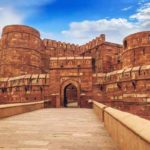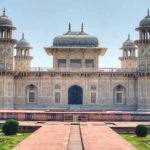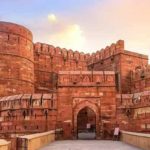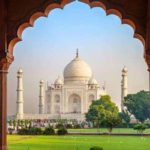Top 10 Tourist Attractions to Visit in Agra As the City of the Taj, Agra was immortalised. It doesn’t take long for the roving eye, however to discover that Agra has more than just the fabled Taj Mahal. The city is a virtual portal to the discovery world… A freeze-frame from a sparkling period that has long since passed by. The area of Agra is defined as ‘Agraban’ (an integral part of Braj Bhumi or Lord Krishna’s land) in the great epic ‘Mahabharat‘. The root of Agra in 1475 A.D., the reign of Raja Badal Singh, is outlined in the latter part of Indian history.
During the rule of the Afghan King, Sikandar Lodhi, who had made it the capital of his kingdom, Agra came to the fore. The Mughal Emperor Babar later took on the challenge of making Agra, a distinctive character and beauty of his own, in 1526 A.D. Emperor Babar, the visionary that he was and great patron of the arts, brought about a shift in the culture and style of life among the people of Agra, which then brought forth some of the finest craftsmen, musicians, statesmen, warriors and nobility that had ever witnessed this part of India, the golden age of the history of Agra, so began to set in. The next few hundred years of Agra saw the rise of the pomp and pageantry of the three great Mughal monarchs, Emperor Akbar, Jahangir and ShahJahan, all of whom lavished their love and wealth enormously on this fabled city to turn the land into one of the great art, music, learning and trade centres.
Most of the remarkable past life of the city is a witness to the majesty of the buildings, the beautiful arts and crafts and not to forget, the attraction of excellent cuisine…. Both of them, loved as invaluable legacies of a nostalgic past. Most of its glorious past has been impressively preserved by the older city of Agra…… captivating every tourist with fond memories to carry home. Today, adjacent to tradition, luxury and modern comfort also exist: luxury hotels, shopping malls and plazas, broad avenues and a superb choice of leisure, industry, sports, pleasure, education and arts venues.
Agra flows through the Yamuna River, and this ancient city sets the perfect tone for a ride to the Heritage Arc. A homage to the imagination of a great emperor who gave the world a sign of everlasting love, the Taj Mahal is a sparkling monument in marble. The Taj Mahal provides the visitor with untold possibilities to explore the architecture, stone work, inlay work, marble embroidery, woodwork and other examples of the artistic genius of man that has gone into its making.
Many ancient temples, mosques, forts, mausoleums, tombs and historical monuments are housed in the city. Apart from the Taj Mahal, the other important monuments in Agra are Agra Fort, Fatehpur Sikri, Akbar’s Tomb, Sikandra, Swami Bagh Samadhi, Jama Masjid and Ram Bagh. The city has traditional paintings, folk dances, folk music and embroidery in its own unique style. Agra is renowned for leather products, exquisite carpets, gold and silver jewellery and handicrafts such as zari zardozi, carving and inlay work on marble and stone.
The best time to visit Agra is between November and March, during the winter season. The temperature is moderate during this period, with many festivals coinciding. The famous 10 day long festival, Taj Mahotsav, is celebrated each year during the month of February. A visit to this fair is a must for admirers of art, craft and culture. The other big festivals are the Ram Bharat, Kailash Fair and Bateshwar Fair.
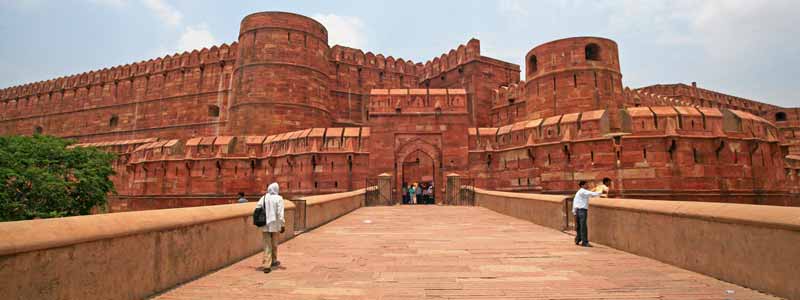
Agra Red Fort
In the city of Agra in India, Agra Fort is a historical fort. Until 1638, when the capital was transferred from Agra to Delhi, it was the main residence of the emperors of the Mughal Dynasty. It is about 2.5 km northwest of its most prominent sister monument, the Taj Mahal. The Agra Fort is a UNESCO World Heritage site. As a walled city, the fort can be represented more accurately.
The triumphant Babur lived in the fort, in the palace of Ibrahim Lodi, after the First Battle of Panipat in 1526. He built a Baoli in it later. In 1530, in the fort, his successor, Humayun, was crowned. He was defeated by Sher Shah Suri in 1540 at Bilgram. The fort stayed with the Suris until 1555, when it was recaptured by Humayun. The general of Adil Shah Suri, Hemu, recaptured Agra in 1556 and pursued its fleeing governor to Delhi, where in the Battle of Tughlaqabad he encountered the Mughals. Sheesh Mahal, Agra Fort: The effect created at Sheesh Mahal, Agra Fort, by lighting candles.
Akbar made it his capital, recognising the importance of its central situation, and arrived in 1558 in Agra. This was reported by his historian, Abul Fazl, as being a brick fort known as ‘Badalgarh.’ It was in a ruined state, and Akbar rebuilt it in Rajasthan with red sandstone from the Barauli region of Dhaulpur district. The foundation was laid by architects and it was constructed with bricks in the inner core and sandstone on external surfaces. For eight years, about 4,000 builders worked on it daily, finishing it in 1573.
It was only during the reign of the grandson of Akbar, Shah Jahan, that the site assumed its current status. In memory of his wife Mumtaz Mahal, Shah Jahan constructed the beautiful Taj Mahal. Shah Jahan preferred to have buildings constructed from white marble, unlike his grandfather. To make his own, he destroyed some of the earlier buildings inside the fort.
Shah Jahan was deposed at the end of his life and restrained in the fort by his uncle, Aurangzeb. It is rumoured that in Muasamman Burj, a tower with a marble balcony overlooking the Taj Mahal, Shah Jahan died.
In the early 18th century, the fort was attacked and taken by the Maratha Empire. It changed hands several times between the Marathas and their enemies thereafter. Marathas remained out of the area for the next decade after Ahmad Shah Abdali’s disastrous defeat at the Third Battle of Panipat in 1761. In 1785, Mahadji Shinde eventually captured the fort. During the Second Anglo-Maratha War, in 1803, it was lost to the British by the Marathas.
During the Indian revolt of 1857, which triggered the end of the rule of the British East India Company in India, the fort was the site of a war and led to a century of direct rule of India by Britain.
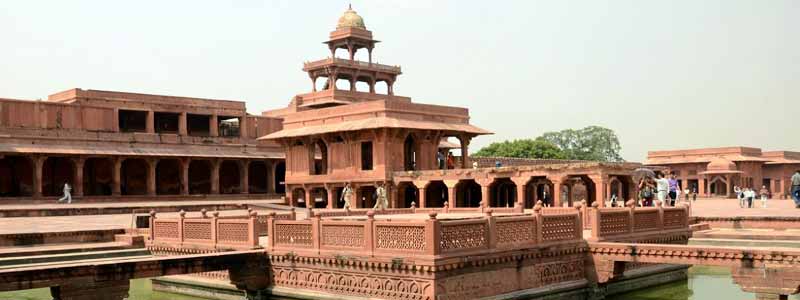
Fatehpur Sikri
The crowning architectural legacy of the Mughal Emperor Akbar, who established it in 1571, is considered to be Fatehpur Sikri. The town derives part of its name from Sikri, a village that existed on the very spot where it was founded. According to tradition, Akbar visited this town and consulted a Sufi saint by the name of Shaikh Salim Chishti. The saint predicted the birth of his successor, and Akbar began building his capital in the village when the prophecy was fulfilled.
Fatehpur Sikri served as the capital of the Mughal Empire from 1571 to 1585. When Akbar returned victorious from his Gujarat campaign in 1573, to celebrate the victory, the city was called Fatehpur Sikri or the City of Victory. He left the town when he proceeded to Punjab in 1585 to fight for his next military campaign. It is suspected that because of two primary factors, the shortage of water and the instability in the north-western part of the world, the city was abandoned. Akbar later moved his empire’s capital to Lahore and then to Agra, and Fatehpur Sikri became a totally deserted city by 1610.
They built an administrative centre here much later, when the colonial rulers invaded Agra in 1803, which remained functional until 1850. Under the orders of the Marquess of Hastings, the monuments at Fatehpur Sikri were restored in 1815.
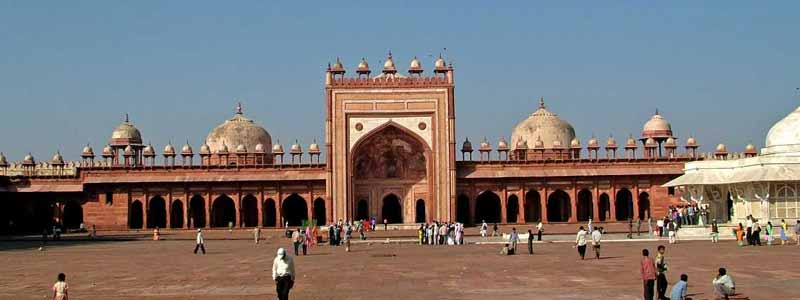
Jama Masjid
Just across from Agra Fort, Jama Masjid is located. It is also popularly known as the Friday Mosque or Jami Masjid and is one of the well-known tourist places in Agra.
Emperor Shah Jahan designed Jama Masjid at the expense of Rs 5 lakhs for his favourite daughter Jahanara Begum’s wish, and it took 5 years to build and was completed in 1649 AD. It is one of India’s largest mosques. The structure of red sandstone was designed in a traditional Mughal style. It sits on an elevated plinth and is accessed by stairs. It consists of a spacious elevated courtyard, bordered to the north and south by arched porticos, with a fountain in its middle. An arched portico and a wide entrance had once bordered the eastern end, but those were demolished by the British in 1857 when the railway line to Agra was being constructed.
The prayer hall occupies the western end of the courtyard and is divided into five parts and topped by three wide domes and consists of a long rectangular structure. All the domes have inverted finials of lotus and kalash on the top. There are five archways linking the prayer hall to the courtyard, the central one of which is framed by a wide Iwan portico and a white marble facade with Persian calligraphy. Two small, slender minarets decorated in a zigzag pattern flanked the central archway once but the minaret on the right side was lost. The top of the facade is a series of Chhatris.
There is a stunning mihrab and pulpit in white marble on the interior of the western wall. In praise of Jahanara and Shah Jahan, the Persian inscription in white marble incrusted with black stone is on the archway of the central portal. It is said that an octagonal (Muthamman) Chowk was constructed between the Delhi Gate and the Jama Masjid and was once surrounded by a market place called Tripolia. But in 1871-73, it was later demolished in order to gain space to lay the railway tracks for the city.
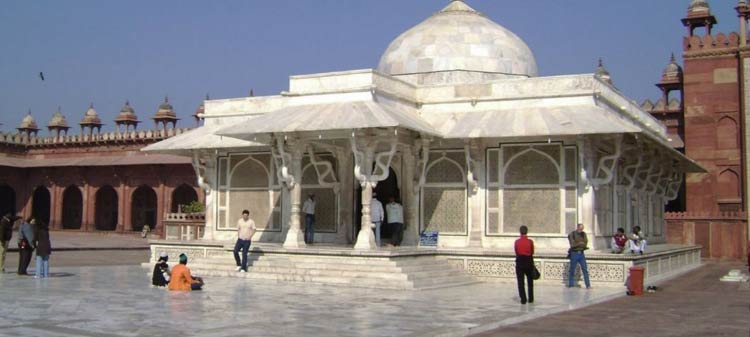
Moti Masjid
The capital of the Mughal era was once Agra. This then led to the rapid growth of the city and many gigantic monuments were constructed that still remember one of the Mughal emperors’ sheer power and intellect. The best place to witness the same is Moti Masjid in the Agra Fort in Agra. The Mughal period was an era of prosperity and happiness characterised by the numerous architectural wonders spread all over India and the beautiful city of Agra in particular. One of these magnificent monuments is Agra’s Moti Masjid.
Shah Jahan established the Moti Masjid (Pearl Mosque) in Agra. Numerous architectural wonders were constructed during the reign of Shah Jahan, the Mughal emperor. The Taj Mahal was the most famous of them. Moti Masjid received the Pearl Mosque epithet for shining like a pearl. It is maintained that Shah Jahan designed this mosque for his royal court members.
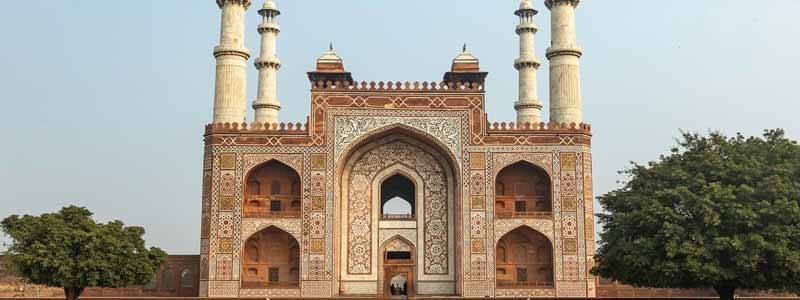
Sikandra Fort
Sikandra, which is just 13 km away. The last resting place of the Mughal Emperor Akbar is at Agra Fort. Akbar was one of the most secular royalties of his time and the greatest of the Mughal emperors. A great patron of the arts, literature, philosophy and science, he was the successor to a long tradition of Oriental refinement. A visit to the monument of Akbar opens before one the completeness of the personality of Akbar as complete as that of Mumtaz Mahal’s Taj Mahal does. In the midst of a lush garden is Akbar’s massive, beautifully carved, red-ochre sandstone tomb. Akbar planned his own tomb himself and chose a fitting location for it. In 1613, Akbar’s son Jahangir finished the construction of this pyramidal tomb.
In the middle of a large garden, which is surrounded on all sides by high walls, stands the tomb. A monumental gateway is in the midst of each enclosed wall. On the traditional Charbhag plan, the entire garden is divided into four equal quarters. A high terrace or elevated path with a narrow shallow water channel running in the middle divides each quarter. Every terrace has a tank with fountains in the middle. To the crypt, which has five storeys and is in the form of a truncated pyramid, a wide paved causeway leads. The main tomb has a distinctive square style that is peculiar to all other Mughal buildings.
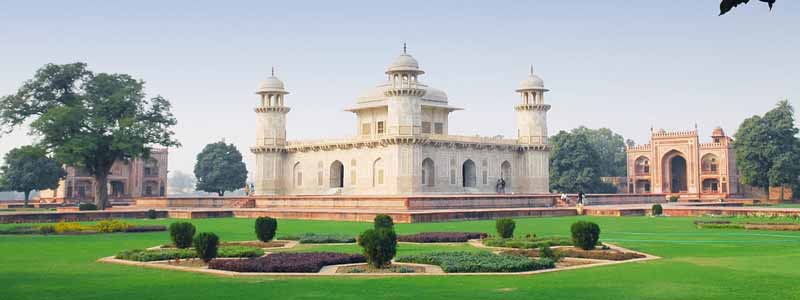
Itmad-Ud-Daulah’s Tomb
A Mughal mausoleum in the city of Agra in the Indian state of Uttar Pradesh is the Tomb of Itmad-ud-Daulah. The tomb of I’timad-ud-Daulah is sometimes identified as a “jewel box” often called the “Baby Taj” and is sometimes regarded as a draught of the Taj Mahal.
The tomb of Itimad-ud-Daula is a stunning mausoleum located on the Yamuna River just outside Agra, widely referred to in tourist literature as the Little Taj” and should be appreciated in its own right and not as a miniature version of the Taj Mahal. This small mausoleum, constructed between 1622 and 1628 by the Mughal empress Nur Jahan for her parents, Itimad-ud-Daula and Asmat Begum, is the first example of a Mughal tomb faced in white marble that used such a large use of stone inlay to decorate its exterior.
Noor Jahan, Jahangir’s wife, commissioned the mausoleum for her father, Mirza Ghiyas Beg, originally a Persian Amir in exile, The one who was given the I’timad-ud-Daulah (pillar of state) title. The grandfather of Mumtaz Mahal (originally called Arjumand Bano, daughter of Asaf Khan), the wife of Emperor Shah Jahan, who was responsible for building the Taj Mahal, was also Mirza Ghiyas Beg. Nur Jehan was also in charge of the construction of the Jehangir Tomb in Lahore.
Mehtab Bagh
In the sequence of 11 parks along the Yamuna River in Agra, the crescent-shaped Mehtab Bagh is the last. Originally built in the early 1500s by the first Mughal emperor-Babur, the park’s history dates back to when there was no Taj Mahal. Later, this garden, however, went into disrepair. To shield Taj Mahal from the abrasion of sand, it was Shah Jahan who reconstructed the garden. This garden is situated in such a way that the perfect view of the Taj is provided. At present, one of the most beautiful places to visit in Agra is considered to be Mehtab Bagh, also known as ‘Moonlight Garden’. The past of this attractive garden is known to few, but it is very interesting; the width of the old garden designed by Babur was perfectly matched with that of Taj, and Shah Jahan therefore recognised it as an ideal place to admire the beauty of the Taj Mahal. The construction of this heritage destination in Agra was originally like a charbagh complex – a layout in the Persian style in which the garden is divided into four sections. There were white walkaways, well-ventilated pavilions, beautiful fruit trees and water fountains dividing the complex.
Most of these features were ruined by regular flooding in the early 1900s, and so the whole garden became a mound of sand. The Archaeological Survey of India (ASI) carried out an excavation at the garden site later in the year 1994. It was discovered in this excavation that Shah Jahan decided to build the Taj Mahal replica as his resting place on this very ground was nothing but a myth. The charbagh complex buried under the sand was actually discovered by this excavation. Every significant feature of this famous tourist attraction in Agra has now been restored to its original shape. To bring back the old grandeur of this striking garden, a variety of plants such as citrus, hibiscus and guava have also been planted. Mehtab Bagh is also an excellent place to enjoy the wonderful view of the sunset.
Taj Mahal
The Taj Mahal is a white marble mausoleum designed in 1631 by Emperor Shah Jahan for his second wife Mumtaz Mahal. It is axiomatic to conclude that it is one of the greatest monuments to love ever created because of the storey behind its construction. Thousands of staff have worked on the building for more than 20 years, embellishing it with excellent decorations including white marble screens and semiprecious stone pietra dura inlay. The structure is the tallest Mughal tomb ever constructed, at over 200 feet (60 metres) tall, and is considered to be the single greatest piece of Mughal architecture. At the edge of the Yamuna River in Agra, it is the centrepiece of a vast complex of houses, courtyards, gardens and waterways. This original landscape is mostly intact.
For its outstanding beauty and architectural value, the Taj has long been recognised and has been a UNESCO World Heritage Site since 1982. It is one of India’s national landmarks and every year it receives millions of tourists. This huge influx of tourists imperils the physical fabric of the monument, as with similarly famous, iconic, and fragile sites around the world. Moreover, although new industrial development has been banned in Agra and only non-polluting vehicles are permitted near the Taj, environmental pollution remains a major concern for the conservation of the mausoleum and its surrounding structures. In a landmark judgement in 1996, the Supreme Court of India ordered measures to conserve and secure the Agra ecosystem in order to safeguard the marble façade of the Taj Mahal. At the 1996 World Monuments Watch, the Taj Mahal was included to draw attention to the urgent need for a comprehensive plan for site management to establish a structure for ongoing maintenance, tourism management, protection, and improved site understanding. In the preamble to its judgement, the Court’s judgement cited World Monuments Watch, stressing international concern for the site.
Chini Ka Rauza
The tomb of Allama Afzal Khan Mullah of Shiraz, a scholar and poet who was the Prime Minister of the Mughal Emperor Shah Jahan, is situated 1 km north of Itmad-Ud-tomb, Daulah’s Chini ka Rauza. The tomb, which was built in 1635 AD, has a rectangular shape and is composed of brown stones.
Nowhere is history more rich than it was in Agra. For a long time, the architectural heritage of the Mughal period has been able to preserve its extraordinary system of buildings devoted to the living and the deceased, in a sequence of monuments and tombs that the world is now watching. One of them is Chini ka Rauza, the supreme meeting of the old and the new, a testament to honour and patronage and impressive architectural finesse jutting out of the very walls of the monument. The tomb of Allama Afzal Khan Mullah of Shiraz, a scholar and poet who was the Prime Minister of the Mughal Emperor Shah Jahan, is situated 1 km north of Itmad-Ud-tomb, Daulah’s Chini ka Rauza. The tomb, which was built in 1635 AD, has a rectangular shape and is composed of brown stones. The tiles are in the colours of blue, yellow and green and decorative inscriptions are on the ceilings. It is octagonal in the central chamber and has eight arched recesses. From it, four square chambers emerge and are connected to the side halls and exterior porches. From the central arch, where there are inscriptions marked out with blue tiles, you may reach the Chini ka Rauza.
Akbar’s Tomb
The tomb of Akbar at Sikandra is an outstanding example of the assimilation of various architectural styles and represents a major departure from earlier Mughal buildings. The tomb bears the distinctive taste of the Agra Fort and Fatehpur Sikri’s airy tiered pavilions.
Akbar was the Mughal dynasty’s third emperor who ruled India in the mediaeval era. The Mughal ruler was crowned in 1556, at the tender age of 14, after the sudden death of his father, Humayun. Akbar was not only a competent administrator, but also an art and architecture connoisseur. From the various buildings constructed by him within the precincts of the great Agra Fort, the architectural prowess of this great ruler is apparent. A special mix of various architectural styles is reflected by most of the buildings inside this fort. Later on at Fatehpur Sikri (near Agra), he went on to create the imperial capital. The buildings at Fatehpur Sikri belong to a hybrid style of architecture, cleverly combined with local Rajasthani and Gujarati styles in the predominant Islamic style.
Akbar began constructing the magnificent building at Sikandra before his death in 1605, which his son Jahangir later completed. The tomb is in a wide walled garden on the Delhi-Agra road, as it stands today. It is possible to reach the tomb through an elegant southern gateway that leads into the enormous enclosed garden.
This beautiful gateway is decorated with white floral and geometrical arabesque decorations and coloured marble, crowned with four elegant white marble minarets. First of all the calligraphic decoration is clearly grandiose. A stately composition is the gateway. Others, which are small and plain, flank its high central arch. This gateway’s grandeur makes it the most magnificent gateway to any monument in the country. The charbagh (four gardens) leads to the emperor’s tomb’s pyramidal structure. The tomb is primarily a bright red-tiered building, stacked like a castle of cards to play with. The tomb is distinct in several respects from previous Mughal buildings. There are five levels in the house. The first one is a podium with arches. A highly inlaid framed door is in the middle of each face. The next three levels are made of red sandstone and have no arches, but rows of pillars keep the flat roof in place. The white wall with arches and a replica of the sarcophagus lying open to the sky can be seen on the uppermost terrace. On all four sides, wide panels of superbly designed jali (filigree) screens shape the verandah’s outer wall. The grave of Akbar lies in the basement, reached by a portico draped with beautiful gold, blue, and green floral arabesque stucco paintings by Persian inscriptions.
Anguri Bagh
The 17th-century Anguri Bagh is a fascinating sightseeing attraction in the town of Taj Mahal, Agra. Founded by the Mughal Emperor Shah Jahan, it is one of the main highlights of tourism in Agra. Anguri Bagh’s literal sense is the rich harvest of grapes for which this beautiful tourist place in Agra was once known. Located on the premises of Agra Fort, the garden is bordered on its east by Khas Mahal and the red sandstone arcades on the remaining three sides. Earlier, Anguri Bagh was a significant square for the recreational strolls of the royal ladies. Hammams (bath houses) on the northeast corner of the garden were also erected for them in such a way that they ensured total privacy. This beautiful tourist attraction in Agra currently houses approximately 85 symmetrical gardens. There is also a fountain in the centre that adds more beauty to this place’s exotic grandeur. In addition, the garden also has a reflective pool with scalloped borders, which is also one of this enticing place’s main features.

